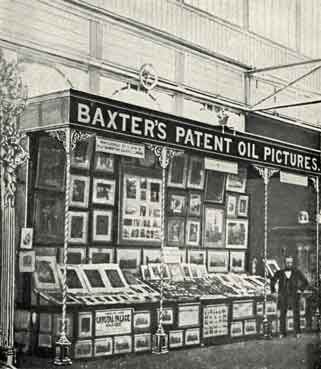Feature August 2012
George Baxter and the Great Exhibition of 1851
There were no Olympic Games in London in 1851 but there was an international event, the Great Exhibition of the Works of Industry of all Nations (The Great Exhibition).
The exhibition was organised by Prince Albert and was held in a temporary structure, located within Hyde Park, designed by Joseph Paxton, that became known as the Crystal Palace.
It was the first in what was to become a series of similar exhibitions of art and industry to be held in UK cities and in cities around the world.
George Baxter's Gems of the Great Exhibition no.2 Belgian department
George Baxter was one of the many exhibitors at this great event.
Although Baxter's work was initially used as book illustrations, he soon found a market for his prints as decorative subjects for the home.
 |
| George Baxter on his stand at the Crystal Palace, Sydenham c.1854 |
His work was widely used by the London Missionary Society and attracted great interest from the Royal Family, especially Prince Albert who encouraged Baxter to exhibit at The Great Exhibition.
On his stand at the exhibition, Baxter had assembled some sixty prints, all produced by his patented colour printing process.
He chose to exhibit historical and architectural subjects, landscapes, portraits and flowers, which by their "delicacy, brilliance, transparency and harmony of colour" (Baxter's words) formed a dazzling array of colour printing that could hardly fail to attract the attention of the thousands of visitors who flocked to the exhibition.
The report by the Fine Arts Committee of the Great Exhibition which appeared in the Official Catalogue says of Baxter's prints: "Nothing can be more beautiful and more perfect in execution than these charming plates, printed in colours."
So great was the demand for Baxter's prints that towards the end of 1851 he extended his premises by acquiring the property next door.
A year later, in 1852, His Imperial Majesty, the Emperor of Austria, ordered that Baxter should be presented with the Great Gold Medal of Austria for 'Literacy and Artistic Merit' and probably in return for this honour Baxter dedicated to the Emperor his book "Baxter's Gems of the Great Exhibition", published in 1854.
This book featured nine of Baxter's views of the interior and exterior of the Great Exhibition.